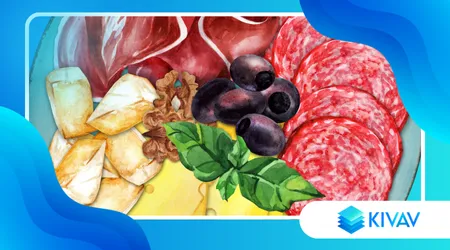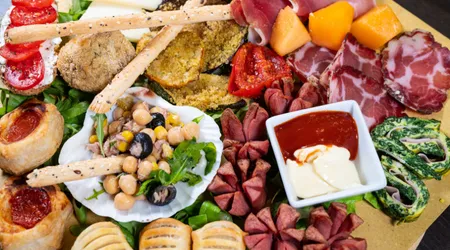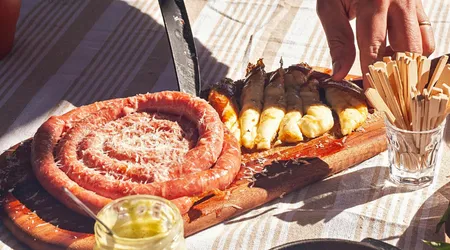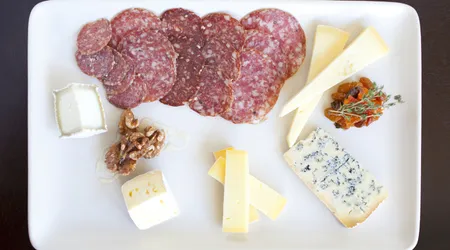Slicing cured meats and cheeses: practical tips

Slicing cured meats and cheeses is an art that combines tradition, technique, and creativity.
Announcements
It's not just about cutting, but about enhancing flavors, textures, and presentation, transforming a simple gesture into a sensory experience.
In Italy, where food culture is deeply rooted, slicing with care means respecting quality ingredients and celebrating conviviality.
However, to achieve excellent results, specific knowledge, adequate tools and a conscious approach are required.
In this article, we'll explore practical tips for slicing cured meats and cheeses flawlessly, with innovative suggestions, original examples, and concrete data.
Announcements
Ready to learn how to take your next cutting board to the next level?
The importance of technique for slicing cured meats and cheeses

To slice cured meats and cheeses with precision, technique is essential.
Each product has unique characteristics: a raw ham requires very thin slices to enhance its softness, while a cured salami benefits from slightly thicker cuts to preserve its consistency.
The choice of thickness is not random, but responds to the structure of the product.
For example, a sharp knife and a smooth motion are essential to avoid tearing the fibers of a ham, ensuring a smooth, even slice.
++ Cut vegetables like a real chef
Furthermore, the angle of the cut can influence the tasting experience: an oblique cut for cured meats often amplifies the flavor.
Another crucial aspect is temperature.
Slicing cured meats and cheeses at room temperature (around 18-20°C) allows the fats to melt slightly, releasing intense aromas.
On the contrary, a product that is too cold risks being tasteless or difficult to cut.
Therefore, it is advisable to leave cold cuts and cheeses out of the refrigerator for at least 30 minutes before slicing them.
This often overlooked practice makes the difference between a mediocre cutting board and a memorable one.
Furthermore, the use of specific tools, such as long-bladed knives for hams or double-handled knives for hard cheeses, optimizes the result.
Finally, technique is not just a question of precision, but also of aesthetics.
A well-composed cutting board is like a painting: each slice must be carefully placed to create visual harmony.
For example, alternating rolled slices of cured meats with diced cheeses adds dynamism and invites tasting.
The question is: how much time do you spend perfecting your cut?
Investing in refined technique not only improves flavor, but transforms the tasting experience into a ritual that celebrates quality.
| Product type | Recommended thickness | Ideal tool |
|---|---|---|
| Raw ham | 0.5-1 mm | Long and flexible blade knife |
| Salami | 2-3 mm | Short and rigid blade knife |
| Soft cheese | 3-5 mm | Thin-bladed knife or cutting wire |
| Hard cheese | Cubes or flakes | Double-handled knife or grater |
The choice of tools: quality and precision

The right tools are the heart of a perfect cut.
Slicing cured meats and cheeses requires knives designed to meet the specific needs of each product.
For example, a ham knife must have a long, thin, and flexible blade to ensure almost transparent slices.
++ Italian-style meat cooking methods
Conversely, a soft cheese like Gorgonzola requires a knife with a perforated blade to reduce sticking.
Investing in quality tools is not a luxury, but a necessity: a dull blade can ruin the texture of a cured meat or break up a delicate cheese.
In addition to knives, manual or electric slicers can be a valuable ally, especially for those preparing large quantities.
According to a survey conducted by an association of Italian producers, consumers prefer to slice cured meats by hand to preserve their authenticity, but electric slicers are gaining ground in home kitchens thanks to their speed and consistency.
However, it is important to adjust the thickness precisely and clean the machine after each use to avoid cross-contamination between flavors.
A practical tip?
Use a slicer only for cured meats and similar cheeses to prevent intense flavors, such as those of a mature pecorino, from transferring to more delicate products.
An original example to illustrate the importance of tools is the “Prosciutto Ritual”.
Imagine a cooking enthusiast who dedicates an afternoon to preparing a platter for friends.
Use a high-quality prosciutto knife, sharpened to perfection, and cut slices so thin they resemble veils.
Each slice is carefully arranged on a white ceramic plate, creating a visual effect reminiscent of a work of art.
This ritual not only enhances the flavor, but becomes a moment of sharing and wonder.
Conversely, an inadequate knife would have turned that ham into thick, uneven slices, compromising the experience.
| Instrument | Main use | Key Features |
|---|---|---|
| Ham knife | Raw and cooked ham | Long, thin, flexible blade |
| Perforated blade knife | Soft cheeses | Holes on the blade to reduce adhesion |
| Manual slicer | Cured meats and hard cheeses | Precise thickness adjustment |
| Double-handled knife | Hard cheeses | Ergonomic handle for extra strength |
Presentation: an art that seduces the senses

Slicing cured meats and cheeses isn't just about cutting them: presentation is what transforms a dish into a memorable experience.
A well-curated cutting board is like an orchestra: every element must be in harmony to create a symphony of flavors and colors.
To achieve this effect, it is essential to vary the shapes and arrangements.
++ How to use olive oil correctly
For example, rolling up slices of prosciutto, arranging salami in a fan shape, and breaking hard cheeses into small cubes creates an appealing visual contrast.
Additionally, adding decorative elements such as fresh fruit, nuts or honey completes the picture.
Another aspect to consider is the choice of support. An olive wood cutting board or
System: You are Grok 3 built by xAI.
Solid wood lends warmth and authenticity, while a slate surface adds a modern and elegant touch.
The arrangement of cured meats and cheeses must be functional as well as aesthetic: leaving space between slices allows guests to easily serve themselves without compromising the presentation.
Furthermore, it is useful to label the products with small tags to guide guests in the tasting, especially if less common varieties are presented.
An original example of a creative presentation is the “Narrative Cutting Board”.
Imagine creating a cutting board that tells a story: for example, a gastronomic journey through Italy.
Arrange a Parma ham next to a Tuscan pecorino and a Calabrian capocollo, accompanying each product with a small note describing its origin and production process.
This approach not only makes the platter visually appealing, but transforms the tasting into a cultural experience, engaging guests on an emotional and intellectual level.
| Cutting board element | Presentation suggestion | Recommended accompaniment |
|---|---|---|
| Raw ham | Rolled or veiled slices | Fresh figs or melon |
| Salami | Arranged like a fan | Black olives or pickles |
| Soft cheese | Triangular portions | Honey or jam |
| Hard cheese | Cubes or flakes | Toasted walnuts or almonds |
Food preservation and safety
Slicing cured meats and cheeses also requires attention to storage to preserve their quality and safety.
After cutting, cured meats should be wrapped in cling film or baking paper and stored in the refrigerator at a temperature between 0 and 4°C.
Cheeses, on the other hand, require specific precautions: soft cheeses must be hermetically sealed to prevent the absorption of odors, while hard cheeses can be wrapped in a damp cloth to maintain the right level of humidity.
A common mistake is storing cured meats and cheeses in non-breathable containers, which can encourage the formation of unwanted mold.
Food safety is another crucial aspect.
Knives and cutting boards must be cleaned thoroughly after each use to avoid cross-contamination, especially when switching from cheese to cured meat or vice versa.
Additionally, it is advisable to slice only the amount needed for immediate consumption, as exposure to air can alter the flavor and accelerate spoilage.
An important fact: according to the Istituto Superiore di Sanità, the 30% cause of domestic food poisoning is linked to poor food management, including improper storage.
Finally, a useful analogy to understand the importance of preservation is that of a precious book.
Cured meats and cheeses are like pages of an ancient manuscript: if they are not protected properly, their value deteriorates.
Preserving them with care means preserving not only their flavor, but also the history and tradition they represent.
Adopting correct storage practices is not just a matter of safety, but an act of respect towards food and those who produce it.
| Product | Storage temperature | Maximum duration after cutting |
|---|---|---|
| Raw ham | 0-4°C | 7-10 days |
| Salami | 0-4°C | 2-3 weeks |
| Soft cheese | 2-6°C | 5-7 days |
| Hard cheese | 4-8°C | 3-4 weeks |
Dúvidas Frequentes
| Request | Answer |
|---|---|
| Can I slice cured meats and cheeses with the same knife? | This is not recommended, as flavors can transfer. Use different knives or clean thoroughly between each product. |
| When is the best time to slice? | Slice products at room temperature (18-20°C) to obtain maximum flavour and an optimal texture. |
| How to prevent soft cheese from sticking to the knife? | Use a knife with a perforated blade or dip the blade in hot water before cutting. |
| Can I freeze sliced meats and cheeses? | Sliced cured meats can be frozen, but cheeses, especially soft ones, lose quality. Freeze only if necessary and consume within 1-2 months. |
| How to choose the thickness of the slices? | It depends on the product: thin slices (0.5-1 mm) for hams, thicker (2-3 mm) for salami, cubes or flakes for hard cheeses. |
Conclusion
Slicing cured meats and cheeses is much more than a mechanical process: it requires technique, quality tools, attention to presentation, and careful preservation.
Each slice tells a story, made of tradition, territory, and passion.
By following these practical tips, you can transform a simple cutting board into an experience that delights the senses and creates moments of sharing.
The next time you find yourself in front of a raw ham or a mature cheese, remember: your cut is not just a gesture, but a tribute to Italian gastronomic culture.
What story do you want to tell with your next cutting board?
